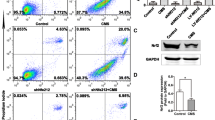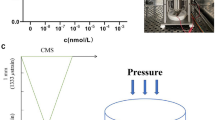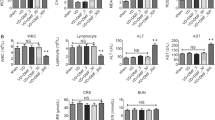Abstract
Introduction and hypothesis
Stress urinary incontinence (SUI) is the most common form of urinary incontinence in women, which affects women’s quality of life worldwide. Mechanical injury of the pelvic floor may disrupt the pelvic supportive tissues and connections via the remodeling of extracellular matrix (ECM), which is supposed to be one of the main pathological mechanisms of SUI.
Methods
The SUI mouse model was established using vaginal distension (VD). Leak point pressure (LPP), maximum cystometric capacity (MCC), collagen, Nrf2 and TGF-β1 in the anterior vaginal wall were measured in either wild-type or Nrf2-knockout (Nrf2-/-) female C57BL/6 mice with or without puerarin treatment. Then, the mechanical stretching (MS) loaded on L929 cells was generated by a four-point bending device. mTGF-β1 or LY2109761 (an inhibitor of TGF-β1) was used to verify the protective effect of puerarin after Nrf2 knockdown or overexpression.
Results
The collagen content of the anterior vaginal tissues in VD mice and LPP and MCC was decreased significantly. Besides, the expression levels of Nrf2, TGF-β1, collagen I and collagen III of MS group were downregulated in L929 cells. Puerarin pretreatment could reverse mechanical injury-induced collagen downregulation and Nrf2/TGF-β1 signaling inhibition. Moreover, both LY2109761 pretreatment and Nrf2 knockdown could attenuate the protective effect of puerarin in the mechanical injury-induced ECM remodeling, whereas exogenous TGF-β1 could counteract the effect of Nrf2 downregulation.
Conclusions
Puerarin protected fibroblasts from mechanical injury-induced ECM remodeling through the Nrf2/TGF-β1 signaling pathway. This might be a new strategy for the treatment of SUI.






Similar content being viewed by others
Data availability
The analyzed datasets generated during the study are available from the corresponding author on reasonable request.
Abbreviations
- SUI:
-
stress urinary incontinence
- ECM:
-
extracellular matrix
- VD:
-
vaginal distension
- LPP:
-
Leak point pressure
- MCC:
-
maximum cystometric capacity
- MS:
-
mechanical stretching
- TGF-β1:
-
transforming growth factor β1
- ROS:
-
reactive oxygen species.
References
Rada MP, Pergialiotis V, Betschart C, Falconi G, Haddad JM, Doumouchtsis SK. A protocol for developing, disseminating, and implementing a core outcome set for stress urinary incontinence. Medicine (Baltimore). 2019;98:e16876. https://doi.org/10.1097/MD.0000000000016876.
Peyrat L, Haillot O, Bruyere F, Boutin JM, Bertrand P, Lanson Y. Prevalence and risk factors of urinary incontinence in young and middle-aged women. Bju Int. 2002;89:61–6. https://doi.org/10.1046/j.1464-4096.2001.01813.x.
Tang J, Li B, Liu C, Li Y, Li Q, Wang L, Min J, Hu M, Hong S, Hong L. Mechanism of mechanical trauma-induced extracellular matrix remodeling of fibroblasts in association with Nrf2/ARE signaling suppression mediating TGF-beta1/Smad3 signaling inhibition. Oxid Med Cell Longev. 2017;2017:8524353. https://doi.org/10.1155/2017/8524353.
Choy KW, Liu YM, Chu CY, Wang CC, Lui WT, Lee LL, Pang MW, Rogers MS, Yip SK. High isoprostane level in cardinal ligament-derived fibroblasts and urine sample of women with uterine prolapse. BJOG. 2008;115:1179–83. https://doi.org/10.1111/j.1471-0528.2008.01806.x.
Kim EJ, Chung N, Park SH, Lee KH, Kim SW, Kim JY, Bai SW, Jeon MJ. Involvement of oxidative stress and mitochondrial apoptosis in the pathogenesis of pelvic organ prolapse. J Urol. 2013;189:588–94. https://doi.org/10.1016/j.juro.2012.09.041.
Bryan HK, Olayanju A, Goldring CE, Park BK. The Nrf2 cell defence pathway: Keap1-dependent and -independent mechanisms of regulation. Biochem Pharmacol. 2013;85:705–17. https://doi.org/10.1016/j.bcp.2012.11.016.
Zhou H, Li X, Shang Y, Chen K. Radical scavenging activity of puerarin: a theoretical study. Antioxidants (Basel). 2019;8. https://doi.org/10.3390/antiox8120590.
Jeon YD, Lee JH, Lee YM, Kim DK. Puerarin inhibits inflammation and oxidative stress in dextran sulfate sodium-induced colitis mice model. Biomed Pharmacother. 2020;124:109847. https://doi.org/10.1016/j.biopha.2020.109847.
Li X, Zhang J, Zhang X, Dong M. Puerarin suppresses MPP(+)/MPTP-induced oxidative stress through an Nrf2-dependent mechanism. Food Chem Toxicol. 2020;144:111644. https://doi.org/10.1016/j.fct.2020.111644.
Min J, Li B, Liu C, Hong S, Tang J, Hu M, Liu Y, Li S, Hong L. Therapeutic Effect and Mechanism of Electrical Stimulation in Female Stress Urinary Incontinence. Urology. 2017;104:45–51. https://doi.org/10.1016/j.urology.2017.02.005.
Li X, Zhu Q, Zheng R, Yan J, Wei M, Fan Y, Deng Y, Zhong Y. Puerarin Attenuates Diabetic Nephropathy by Promoting Autophagy in Podocytes. Front Physiol. 2020;11:73. https://doi.org/10.3389/fphys.2020.00073.
Zhang L. Pharmacokinetics and drug delivery systems for puerarin, a bioactive flavone from traditional Chinese medicine. Drug Deliv. 2019;26:860–9. https://doi.org/10.1080/10717544.2019.1660732.
Zeng W, Li Y, Li B, Liu C, Hong S, Tang J, Hong L. Mechanical Stretching induces the apoptosis of parametrial ligament Fibroblasts via the Actin Cytoskeleton/Nr4a1 signalling pathway. Int J Med Sci. 2020;17:1491–8. https://doi.org/10.7150/ijms.46354.
Li Y, Hong L, Liu C, Min J, Hong S, Hu M, Zhao Y, Yang Q, Tang J, He S. Effect of puerarin on collagen metabolism of fibroblasts in pelvic tissue of women with pelvic organ prolapse. Mol Med Rep. 2018;17:2705–11. https://doi.org/10.3892/mmr.2017.8112.
Li Y, Liu C, Li B, Hong S, Min J, Hu M, Tang J, Wang T, Yang L, Hong L. Electrical stimulation activates calpain 2 and subsequently upregulates collagens via the integrin beta1/TGF-beta1 signaling pathway. Cell Signal. 2019;59:141–51. https://doi.org/10.1016/j.cellsig.2019.03.023.
Tang J, Liu C, Min J, Hu M, Li Y, Hong L. Potential therapeutic role of punicalagin against mechanical-trauma-induced stress urinary incontinence via upregulation of Nrf2 and TGF-beta1 signaling : Effect of punicalagin on mechanical trauma induced SUI. Int Urogynecol J. 2017;28:947–55. https://doi.org/10.1007/s00192-017-3283-x.
Wein AJ. Re: A Model for Predicting the Risk of De Novo Stress Urinary Incontinence in Women Undergoing Pelvic Organ Prolapse Surgery. J Urol. 2015;194:470. https://doi.org/10.1016/j.juro.2015.04.009.
Han L, Wang L, Wang Q, Li H, Zang H. Association between pelvic organ prolapse and stress urinary incontinence with collagen. Exp Ther Med. 2014;7:1337–41. https://doi.org/10.3892/etm.2014.1563.
DeLancey JO. Structural support of the urethra as it relates to stress urinary incontinence: the hammock hypothesis. Am J Obstet Gynecol. 1994;170(1713-1720):1720–3. https://doi.org/10.1016/s0002-9378(94)70346-9.
Kokcu A, Yanik F, Cetinkaya M, Alper T, Kandemir B, Malatyalioglu E. Histopathological evaluation of the connective tissue of the vaginal fascia and the uterine ligaments in women with and without pelvic relaxation. Arch Gynecol Obstet. 2002;266:75–8. https://doi.org/10.1007/s004040100194.
Lin G, Shindel AW, Banie L, Deng D, Wang G, Hayashi N, Lin CS, Lue TF. Molecular mechanisms related to parturition-induced stress urinary incontinence. Eur Urol. 2009;55:1213–22. https://doi.org/10.1016/j.eururo.2008.02.027.
Wen Y, Zhao YY, Li S, Polan ML, Chen BH. Differences in mRNA and protein expression of small proteoglycans in vaginal wall tissue from women with and without stress urinary incontinence. Hum Reprod. 2007;22:1718–24. https://doi.org/10.1093/humrep/dem039.
Song J, Zhu Y, Li J, Liu J, Gao Y, Ha T, et al. Pellino1-mediated TGF-beta1 synthesis contributes to mechanical stress induced cardiac fibroblast activation. J Mol Cell Cardiol. 2015;79:145-156. https://doi.org/10.1016/j.yjmcc.2014.11.006
Wen Y, Zhao YY, Polan ML, Chen B. Effect of relaxin on TGF-beta1 expression in cultured vaginal fibroblasts from women with stress urinary incontinence. Reprod Sci. 2008;15:312–20. https://doi.org/10.1177/1933719108315299.
Li BS, Guo WJ, Hong L, Liu YD, Liu C, Hong SS, Wu DB, Min J. Role of mechanical strain-activated PI3K/Akt signaling pathway in pelvic organ prolapse. Mol Med Rep. 2016;14:243–53. https://doi.org/10.3892/mmr.2016.5264.
Bellezza I, Giambanco I, Minelli A, Donato R. Nrf2-Keap1 signaling in oxidative and reductive stress. Biochim Biophys Acta Mol Cell Res. 2018;1865:721–33. https://doi.org/10.1016/j.bbamcr.2018.02.010.
Liu C, Yang Q, Fang G, Li BS, Wu DB, Guo WJ, Hong SS, Hong L. Collagen metabolic disorder induced by oxidative stress in human uterosacral ligamentderived fibroblasts: A possible pathophysiological mechanism in pelvic organ prolapse. Mol Med Rep. 2016;13:2999–3008. https://doi.org/10.3892/mmr.2016.4919.
Grote K, Flach I, Luchtefeld M, Akin E, Holland SM, Drexler H, Schieffer B. Mechanical stretch enhances mRNA expression and proenzyme release of matrix metalloproteinase-2 (MMP-2) via NAD(P)H oxidase-derived reactive oxygen species. Circ Res. 2003;92:e80–6. https://doi.org/10.1161/01.RES.0000077044.60138.7C.
Makpol S, Azura JF, Anum MYY, Zurinah WNW. Modulation of collagen synthesis and its gene expression in human skin fibroblasts by tocotrienol-rich fraction. Arch Med Sci. 2011;7:889–95. https://doi.org/10.5114/aoms.2011.25567.
Deconinck E, Custers D, De Beer JO. Identification of (antioxidative) plants in herbal pharmaceutical preparations and dietary supplements. Methods Mol Biol. 2015;1208:181–99. https://doi.org/10.1007/978-1-4939-1441-8_14.
Acknowledgments
All authors thank all the teachers in the Department of Gynecology and Obstetrics and Central Laboratory, Renmin Hospital of Wuhan University, for their technical assistance.
Funding
The present study was financially supported by the Fundamental Research Funds for the Central Universities (grant number: 2042022kf1110), the National Key R&D Program of China (grant number: 2018YFC2002204 and 2021YFC2701302) and the National Natural Science Foundation of China (grant number: 81971364).
Author information
Authors and Affiliations
Contributions
Yang Li: manuscript writing, investigation and data analysis; Cheng Liu and Lian Yang: development and design of methodology; Lu Li: data collection; Li Hong: project development.
Corresponding author
Ethics declarations
The procedures of the animal study were approved by the ethics committee of the Institutional Animal Care and Use Committee of Renmin Hospital of Wuhan University (20161105).
Conflicts of interest
None.
Additional information
Publisher’s note
Springer Nature remains neutral with regard to jurisdictional claims in published maps and institutional affiliations.
Rights and permissions
Springer Nature or its licensor holds exclusive rights to this article under a publishing agreement with the author(s) or other rightsholder(s); author self-archiving of the accepted manuscript version of this article is solely governed by the terms of such publishing agreement and applicable law.
About this article
Cite this article
Li, Y., Liu, C., Yang, L. et al. Puerarin protects fibroblasts against mechanical stretching injury through Nrf2/TGF-β1 signaling pathway. Int Urogynecol J 33, 2565–2576 (2022). https://doi.org/10.1007/s00192-022-05325-z
Received:
Accepted:
Published:
Issue Date:
DOI: https://doi.org/10.1007/s00192-022-05325-z




